|
01. Reflector Vs Collimator
Although optical element can usually be found in high power LED, the field distribution of LED is usually not tight enough for flashlight application and therefore secondary optical part is required for light collimation.
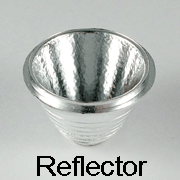
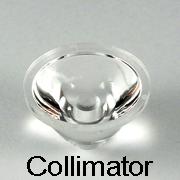
There are two major types of secondary optical part found in flashlight products, they are reflector and collimator. Reflector is a profiled part with reflective surface, the surface is intelligently profiled so as to reflect all the light from the LED to form the required beam angle. The surface of the reflector is being made reflective with a process called vacuum metalizing and Kaper has in-house production facilities to do vacuum metalizing so complete control of quality reflector can be guaranteed.
A deep reflector is usually required for a tight beam, while a highly polished reflector will usually give imperfect beam pattern (as any irregularities in the design of the LED will be projected onto the beam pattern). In order to give better or smoother beam pattern, variances of reflectors is required like orange-peel or diamond reflector in which lots of micro surfaces can help to slightly diffuse the light to give perfect beam pattern. If fabricated incorrectly, the micro surfaces can reduce the efficiency of the optical system. Kaper is professional in manufacturing orange peel reflector with which efficiency loss is so low that can be regarded as negligible.
The other type of secondary optical part is called collimator, which is a solid piece of clear plastic collimating light from LED by a principle called TIR (Total Internal Reflection, the same principle behind fibre optics). Since light is being collimated by TIR, reflective surface is not required for collimator, and due to the characteristic of the principle, collimator is expected to have higher efficiency than reflector. Similar to orange peel or diamond texture found in reflectors, micro lens on the front surface of the collimator are used to diffuse the light when required.
Both reflector and collimator is LED specific which means that a particular model of reflector or collimator can only be used with a particular model of LED. However, sometimes a reflector or collimator can be used with more than one model of LED given that the difference between the LEDs are not too much.
Reflector or Collimator?
This is one of the questions mostly asked by flashlight customers. Among the two, collimator usually costs higher but with higher efficiency, while reflector costs lower and have higher flexibility that it can be made in different sizes. With the technologies and equipments that Kaper has as mentioned above, the orange peel reflector we manufactured is having efficiency as good as collimator (difference is marginal) so although we hate to say that, the choice on which to use really depends on applications.
[ Back ]02. Different Light Units
Units used in battery operating lighting products can sometimes be confusing even to technical people. Here I will try to explain the meaning and differences between those popular units used in portable lighting market in details.
Candela (cd) - One of the seven SI base unit, unit of Luminous Intensity (I), or Light Power per Steradian (SR), while steradian is a unit of 3D cone angle with which the projected area of 1 steradian over a sphere with 1m of radius, is 1 square meter (see diagram below). Earlier 5mm LEDs usually have output defined using mcd (millicandela) while 1000 mcd = 1 cd.
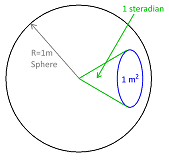
Lumen - Unit of Luminus Flux or Power, defined as I x SR.
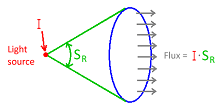
Lux - Unit of Illuminance or Luminous Flux per unit area, equals Lumens per square meter.
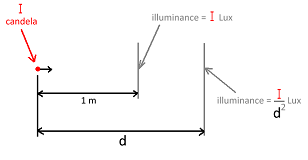
Candlepower - A unit that is already obsoleted.
Some resources misused Candlepower as Candela, but actually 1 candlepower = 0.981 candela.
03. Molding colors of reflector
Q: Will the molding color of the reflector affect the colour temperature of the resulting light beam?
A: No. Kaper has in-house vacuum metalizing facilities and with our quality controlled process, coverage of vacuum metalizing is guaranteed so that the molding color of the reflector will not be able to affect the colour temperature of the resulting light beam.
Q: If molding color does not affect the resulting light beam, what molding color should be used for the reflector?
A: Unless necessary, colorants should not be added for molding reflector as any kind of additive will degrade the surface glossiness of the reflector and in turn will reduce the efficiency of the reflector.
[ Back ]